Synthesis, Molecular and Supramolecular Structures of Symmetric Dinuclear Cd(II) Azido Complex with bis-Pyrazolyl s-Triazine Pincer Ligand
Abstract
:1. Introduction
2. Materials and Methods
2.1. Synthesis of [Cd(PMT)(Cl)(N3)]2
2.2. Physicochemical Characterizations
2.3. Computational Details
3. Results and Discussion
3.1. Chemistry
3.2. Crystal Structure Description
3.3. Analysis of Molecular Packing
3.4. Natural Charge Distribution
3.5. The Atoms in Molecules (AIM) Study
4. Conclusions
Supplementary Materials
Author Contributions
Funding
Data Availability Statement
Acknowledgments
Conflicts of Interest
References
- Mir, M.H.; Koh, L.L.; Tan, G.K.; Vittal, J.J. Single-Crystal to Single-Crystal Photochemical Structural Transformations of Interpenetrated 3 D Coordination Polymers by [2+2] Cycloaddition Reactions. Angew. Chem. Int. Ed. 2010, 49, 390–393. [Google Scholar] [CrossRef] [PubMed]
- Das, L.K.; Gómez-García, C.J.; Ghosh, A. Influence of the central metal ion in controlling the self-assembly and magnetic properties of 2D coordination polymers derived from [(NiL)2M]2+ nodes (M= Ni, Zn and Cd)(H2L= salen-type di-Schiff base) and dicyanamide spacers. Dalton Trans. 2015, 44, 1292–1302. [Google Scholar] [CrossRef] [PubMed]
- Das, L.K.; Diaz, C.; Ghosh, A. Antiferromagnetic mixed-valence Cu (I)–Cu (II) two-dimensional coordination polymers constructed by double oximato bridged Cu(II) dimers and CuISCN based one-dimensional anionic chains. Cryst. Growth Des. 2015, 15, 3939–3949. [Google Scholar] [CrossRef]
- Yamada, T.; Otsubo, K.; Makiura, R.; Kitagawa, H. Designer coordination polymers: Dimensional crossover architectures and proton conduction. Chem. Soc. Rev. 2013, 42, 6655–6669. [Google Scholar] [CrossRef] [PubMed]
- Li, H.; Wang, Y.; He, Y.; Xu, Z.; Zhao, X.; Han, Y. Synthesis of several novel coordination complexes: Ion exchange, magnetic and photocatalytic studies. New J. Chem. 2017, 41, 1046–1056. [Google Scholar] [CrossRef]
- Mondal, M.; Jana, S.; Drew, M.G.; Ghosh, A. Application of two Cu (II)-azido based 1D coordination polymers in optoelectronic device: Structural characterization and experimental studies. Polymer 2020, 204, 122815. [Google Scholar] [CrossRef]
- Zhang, Z.; Zhao, Y.; Gong, Q.; Li, Z.; Li, J. MOFs for CO2 capture and separation from flue gas mixtures: The effect of multifunctional sites on their adsorption capacity and selectivity. Chem. Commun. 2013, 49, 653–661. [Google Scholar] [CrossRef]
- Zeng, L.W.; Hu, K.Q.; Mei, L.; Li, F.Z.; Huang, Z.W.; An, S.W.; Chai, Z.F.; Shi, W.Q. Structural diversity of bipyridinium-based uranyl coordination polymers: Synthesis, characterization, and ion-exchange application. Inorg. Chem. 2019, 58, 14075–14084. [Google Scholar] [CrossRef]
- He, Y.; Li, B.; O’Keeffe, M.; Chen, B. Multifunctional metal–organic frameworks constructed from meta-benzenedicarboxylate units. Chem. Soc. Rev. 2014, 43, 5618–5656. [Google Scholar] [CrossRef]
- Lee, M.M.; Kim, H.Y.; Hwang, I.H.; Bae, J.M.; Kim, C.; Yo, C.H.; Kim, Y.; Kim, S.J. Cd II MOFs Constructed Using Succinate and Bipyridyl Ligands: Photoluminescence and Heterogeneous Catalytic Activity. Bull. Korean Chem. Soc. 2014, 35, 1777–1783. [Google Scholar] [CrossRef]
- Dutta, B.; Jana, R.; Bhanja, A.K.; Ray, P.P.; Sinha, C.; Mir, M.H. Supramolecular aggregate of Cadmium (II)-based one-dimensional coordination polymer for device fabrication and sensor application. Inorg. chem. 2019, 58, 2686–2694. [Google Scholar] [CrossRef] [PubMed]
- Ghorai, P.; Dey, A.; Brandão, P.; Benmansour, S.; Gómez García, C.J.; Ray, P.P.; Saha, A. Multifunctional Ni(II)-Based Metamagnetic Coordination Polymers for Electronic Device Fabrication. Inorg. chem. 2020, 59, 8749–8761. [Google Scholar] [CrossRef]
- Liu, J.Q.; Luo, Z.D.; Pan, Y.; Singh, A.K.; Trivedi, M.; Kumar, A. Recent developments in luminescent coordination polymers: Designing strategies, sensing application and theoretical evidences. Coord. Chem. Rev. 2020, 406, 213145. [Google Scholar] [CrossRef]
- Zhang, X.; Wang, W.; Hu, Z.; Wang, G.; Uvdal, K. Coordination polymers for energy transfer: Preparations, properties, sensing applications, and perspectives. Coord. Chem. Rev. 2015, 284, 206–235. [Google Scholar] [CrossRef]
- Xie, Z.; Ma, L.; de Krafft, K.E.; Jin, A.; Lin, W. Porous phosphorescent coordination polymers for oxygen sensing. J. Am. Chem. Soc. 2010, 132, 922–923. [Google Scholar] [CrossRef]
- Alsharabasy, A.M.; Pandit, A.; Farràs, P. Recent Advances in the Design and Sensing Applications of Hemin/Coordination Polymer-Based Nanocomposites. Adv. Mater. 2021, 33, 2003883. [Google Scholar] [CrossRef] [PubMed]
- Stavila, V.; Talin, A.A.; Allendorf, M.D. MOF-based electronic and opto-electronic devices. Chem. Soc. Rev. 2014, 43, 5994–6010. [Google Scholar] [CrossRef] [Green Version]
- Dhakshinamoorthy, A.; Garcia, H. Catalysis by metal nanoparticles embedded on metal–organic frameworks. Chem. Soc. Rev. 2012, 41, 5262–5284. [Google Scholar] [CrossRef]
- Allendorf, M.D.; Bauer, C.A.; Bhakta, R.K.; Houk, R.J.T. Luminescent metal–organic frameworks. Chem. Soc. Rev. 2009, 38, 1330–1352. [Google Scholar] [CrossRef]
- Roy, S.; Halder, S.; Drew, M.G.; Ray, P.P.; Chattopadhyay, S. Fabrication of an active electronic device using a hetero-bimetallic coordination polymer. ACS Omega 2018, 3, 12788–12796. [Google Scholar] [CrossRef]
- Kar, P.; Guha, P.M.; Drew, M.G.; Ishida, T.; Ghosh, A. Spin-Canted Antiferromagnetic Phase Transitions in Alternating Phenoxo-and Carboxylato-Bridged MnIII-Salen Complexes. Eur. J. Chem. 2011, 2011, 2075–2085. [Google Scholar]
- Bhowmik, P.; Biswas, S.; Chattopadhyay, S.; Diaz, C.; Gómez-García, C.J.; Ghosh, A. Synthesis, crystal structure and magnetic properties of two alternating double μ 1, 1 and μ 1, 3 azido bridged Cu(II) and Ni(II) chains. Dalton Trans. 2014, 43, 12414–12421. [Google Scholar] [CrossRef] [PubMed]
- Mukherjee, S.; Mukherjee, P.S. Cu II–azide polynuclear complexes of Cu4 building clusters with Schiff-base co-ligands: Synthesis, structures, magnetic behavior and DFT studies. Dalton Trans. 2013, 42, 4019–4030. [Google Scholar] [CrossRef]
- Mautner, F.A.; Fischer, R.C.; Williams, B.R.; Massoud, S.S.; Salem, N.M. Hexnuclear cadmium(II) cluster constructed from tris (2-methylpyridyl) amine (TPA) and azides. Crystals 2020, 10, 317. [Google Scholar] [CrossRef] [Green Version]
- Mautner, F.A.; Fischer, R.C.; Reichmann, K.; Gullett, E.; Ashkar, K.; Massoud, S.S. Synthesis and characterization of 1D and 2D cadmium (II)-2, 2′-bipyridine-N, N′-dioxide coordination polymers bridged by pseudohalides. J. Mol. Struct. 2019, 1175, 797–803. [Google Scholar] [CrossRef]
- Boonmak, J.; Nakano, M.; Chaichit, N.; Pakawatchai, C.; Youngme, S. Spin canting and metamagnetism in 2D and 3D cobalt (II) coordination networks with alternating double end-on and double end-to-end azido bridges. Inorg. Chem. 2011, 50, 7324–7333. [Google Scholar] [CrossRef] [PubMed]
- Mautner, F.A.; Louka, F.R.; Hofer, J.; Spell, M.; Lefèvre, A.; Guilbeau, A.E.; Massoud, S.S. One-dimensional cadmium polymers with alternative di (EO/EE) and di (EO/EO/EO/EE) bridged azide bonding modes. Cryst. Growth Des. 2013, 13, 4518–4525. [Google Scholar] [CrossRef]
- Massoud, S.S.; Louka, F.R.; Obaid, Y.K.; Vicente, R.; Ribas, J.; Fischer, R.C.; Mautner, F.A. Metal ions directing the geometry and nuclearity of azido-metal (II) complexes derived from bis (2-(3, 5-dimethyl-1 H-pyrazol-1-yl) ethyl) amine. Dalton Trans. 2013, 42, 3968–3978. [Google Scholar] [CrossRef]
- Lazari, G.; Stamatatos, T.C.; Raptopoulou, C.P.; Psycharis, V.; Pissas, M.; Perlepes, S.P.; Boudalis, A.K. A metamagnetic 2D copper (II)-azide complex with 1D ferromagnetism and a hysteretic spin-flop transition. Dalton Trans. 2009, 17, 3215–3221. [Google Scholar] [CrossRef]
- You, Y.S.; Yoon, J.H.; Kim, H.C.; Hong, C.S. Chiral azide-bridged two-dimensional Cu(II) compounds showing a field-induced spin–flop transition. Chem. Commun. 2005, 32, 4116–4118. [Google Scholar] [CrossRef]
- Gao, E.Q.; Bai, S.Q.; Wang, C.F.; Yue, Y.F.; Yan, C.H. Structural and magnetic properties of three one-dimensional azido-bridged copper (II) and manganese (II) coordination polymers. Inorg. Chem. 2003, 42, 8456–8464. [Google Scholar] [CrossRef]
- Sun, D.; Han, L.L.; Yuan, S.; Deng, Y.K.; Xu, M.Z.; Sun, D.F. Four new Cd (II) coordination polymers with mixed multidentate N-donors and biphenyl-based polycarboxylate ligands: Syntheses, structures, and photoluminescent properties. Cryst. Growth Des. 2013, 13, 377–385. [Google Scholar] [CrossRef]
- Wei, G.; Shen, Y.F.; Li, Y.R.; Huang, X.C. Synthesis, crystal structure, and photoluminescent properties of ternary Cd (II)/triazolate/chloride system. Inorg. Chem. 2010, 49, 9191–9199. [Google Scholar] [CrossRef] [PubMed]
- Du, M.; Jiang, X.J.; Zhao, X.J. Direction of unusual mixed-ligand metal–organic frameworks: A new type of 3-D polythreading involving 1-D and 2-D structural motifs and a 2-fold interpenetrating porous network. Chem. Commun. 2005, 5521–5523. [Google Scholar] [CrossRef] [PubMed]
- Chen, F.; Wu, M.F.; Liu, G.N.; Wang, M.S.; Zheng, F.K.; Yang, C.; Xu, Z.N.; Liu, Z.F.; Guo, G.C.; Huang, J.S. Zinc (II) and Cadmium (II) Coordination Polymers Based on 3-(5H-Tetrazolyl) benzoate Ligand with Different Coordination Modes: Hydrothermal Syntheses, Crystal Structures and Ligand-Centered Luminescence. Eur. J. Inorg. Chem. 2010, 2010, 4982–4991. [Google Scholar] [CrossRef]
- Huang, F.P.; Zhang, Q.; Yu, Q.; Bian, H.D.; Liang, H.; Yan, S.P.; Liao, D.Z.; Cheng, P. Coordination assemblies of CoII/NiII/ZnII/CdII with succinic acid and bent connectors: Structural diversity and spin-canted antiferromagnetism. Cryst. Growth Des. 2012, 12, 1890–1898. [Google Scholar] [CrossRef]
- Liu, X.; Zhang, N.; Zhou, J.; Chang, T.; Fang, C.; Shangguan, D. A turn-on fluorescent sensor for zinc and cadmium ions based on perylene tetracarboxylic diimide. Analyst. 2013, 138, 901–906. [Google Scholar] [CrossRef] [PubMed]
- Majumdar, D.; Dey, S.; Sreejith, S.S.; Biswas, J.K.; Mondal, M.; Shukla, P.; Das, S.; Pal, T.; Das, D.; Bankura, K.; et al. Syntheses, crystal structures and photo physical aspects of azido-bridged tetranuclear cadmium (II) complexes: DFT/TD-DFT, thermal, antibacterial and anti-biofilm properties. J. Mol. Struct. 2019, 1179, 694–708. [Google Scholar] [CrossRef]
- Majumder, S.; Mandal, L.; Mohanta, S. Syntheses, structures, and steady state and time resolved photophysical properties of a tetraiminodiphenol macrocyclic ligand and its dinuclear zinc (II)/cadmium (II) complexes with coordinating and noncoordinating anions. Inorg. Chem. 2012, 51, 8739–8749. [Google Scholar] [CrossRef]
- Liu, X.; Hamon, J.R. Recent developments in penta-, hexa-and heptadentate Schiff base ligands and their metal complexes. Coord. Chem. Rev. 2019, 389, 94–118. [Google Scholar] [CrossRef]
- Soliman, S.M.; El-Faham, A. Synthesis, characterization, and structural studies of two heteroleptic Mn(II) complexes with tridentate N,N,N-pincer type ligand. J. Coord. Chem. 2018, 71, 2373–2388. [Google Scholar] [CrossRef]
- Soliman, S.M.; Almarhoon, Z.; El-Faham, A. Synthesis, Molecular and Supramolecular Structures of New Cd(II) Pincer-Type Complexes with s-Triazine Core Ligand. Crystals 2019, 9, 226. [Google Scholar] [CrossRef] [Green Version]
- Soliman, S.M.; Elsilk, S.E.; El-Faham, A. Synthesis, structure and biological activity of zinc (II) pincer complexes with 2,4-bis (3,5-dimethyl-1H-pyrazol-1-yl)-6-methoxy-1,3,5-triazine. Inorg. Chim. Acta 2020, 508, 119627. [Google Scholar] [CrossRef]
- Soliman, S.M.; Elsilk, S.E.; El-Faham, A. Novel one-dimensional polymeric Cu(II) complexes via Cu(II)-assisted hydrolysis of the 2,4-bis(3,5-dimethyl-1H-pyrazol-1-yl)-6-methoxy-1,3,5-triazine pincer ligand: Synthesis, structure, and antimicrobial activities. Appl. Organomet. Chem. 2020, 34, e5941. [Google Scholar] [CrossRef]
- Soliman, S.M.; Al-Rasheed, H.H.; Elsilk, S.E.; El-Faham, A.A. Novel Centrosymmetric Fe(III) Complex with Anionic Bis-pyrazolyl-s-triazine Ligand; Synthesis, Structural Investigations and Antimicrobial Evaluations. Symmetry 2021, 13, 1247. [Google Scholar] [CrossRef]
- Refaat, H.M.; Alotaibi, A.A.M.; Dege, N.; El-Faham, A.; Soliman, S.M. Syntheses, X-ray structure and biological studies of binuclear μ-oxo diiron complexes with s-triazine pincer ligand. Inorg. Chim. Acta 2022, 543, 121196. [Google Scholar]
- Sheldrick, G.M. SAINT; Siemens analytical X-ray Instruments Inc.: Madison, WI, USA, 1995. [Google Scholar]
- Sheldrick, G.M. SADABS; University of Goettingen: Goettingen, Germany, 1996. [Google Scholar]
- Sheldrick, G.M. SHELXT-Integrated space-group and crystal-structure determination. Acta Cryst. A 2015, 71, 3–8. [Google Scholar] [CrossRef] [Green Version]
- Turner, M.J.; McKinnon, J.J.; Wolff, S.K.; Grimwood, D.J.; Spackman, P.R.; Jayatilaka, D.; Spackman, M.A. Crystal Explorer17; University of Western Australia: Crawley, Australia, 2017. [Google Scholar]
- Frisch, M.J.; Trucks, G.W.; Schlegel, H.B.; Scuseria, G.E.; Robb, M.A.; Cheeseman, J.R.; Scalmani, G.; Barone, V.; Mennucci, B.; Petersson, G.A.; et al. GAUSSIAN 09; Revision A02; Gaussian Inc.: Wallingford, CT, USA, 2009. [Google Scholar]
- Glendening, E.D.; Reed, A.E.; Carpenter, J.E.; Weinhold, F. NBO Version 3.1, CI; University of Wisconsin: Madison, MI, USA, 1998. [Google Scholar]
- Adamo, C.; Barone, V. Exchange functionals with improved long-range behavior and adiabatic connection methods without adjustable parameters: The mPW and mPW1PW models. J. Chem. Phys. 1998, 108, 664–675. [Google Scholar] [CrossRef]
- Feller, D. The role of databases in support of computational chemistry calculations. J. Comp. Chem. 1996, 17, 1571–1586. [Google Scholar] [CrossRef]
- Schuchardt, K.L.; Didier, B.T.; Elsethagen, T.; Sun, L.; Gurumoorthi, V.; Chase, J.; Li, J.; Windus, T.L. Basis set exchange: A community database for computational sciences. J. Chem. Inf. Model. 2007, 47, 1045–1052. [Google Scholar] [CrossRef] [Green Version]
- Bader, R.F.W. Atoms in Molecules: A Quantum Theory; Oxford University Press: Oxford, UK, 1990. [Google Scholar]
- Lu, T.; Chen, F. Multiwfn: A multifunctional wavefunction analyzer. J. Comp. Chem. 2012, 33, 580–592. [Google Scholar] [CrossRef] [PubMed]
- Soliman, S.M.; El-Faham, A. Synthesis, X-ray structure, and DFT studies of five and eight-coordinated Cd(II) complexes with s-triazine N-pincer chelate. J. Coord. Chem. 2019, 72, 1621–1636. [Google Scholar] [CrossRef]
- Matta, C.F.; Hernandez-Trujillo, J.; Tang, T.-H.; Bader, R.F.W. Hydrogen–Hydrogen Bonding: A Stabilizing Interaction in Molecules and Crystals. Chem. Eur. J. 2003, 9, 1940–1951. [Google Scholar] [CrossRef] [PubMed]
- Grabowski, S.J.; Pfitzner, A.; Zabel, M.; Dubis, A.T.; Palusiak, M. Intramolecular H···H Interactions for the Crystal Structures of [4-((E)-But-1-enyl)-2,6-dimethoxyphenyl]pyridine-3-carboxylate and [4-((E)-Pent-1-enyl)-2,6-dimethoxyphenyl]pyridine-3-carboxylate; DFT Calculations on Modeled Styrene Derivatives. J. Phys. Chem. B 2004, 108, 1831–1837. [Google Scholar] [CrossRef]
- Matta, C.F.; Castillo, N.; Boyd, R.J. Characterization of a Closed-Shell Fluorine−Fluorine Bonding Interaction in Aromatic Compounds on the Basis of the Electron Density. J. Phys. Chem. A 2005, 109, 3669–3681. [Google Scholar] [CrossRef]
- Pendás, A.M.; Francisco, E.; Blanco, M.A.; Gatti, C. Bond Paths as Privileged Exchange Channels. Chem. Eur. J. 2007, 13, 9362–9371. [Google Scholar] [CrossRef]
- Oliveira, B.G.; Pereira, F.S.; de Araujo, R.C.M.C.; Ramos, M.N. The hydrogen bond strength: New proposals to evaluate the intermolecular interaction using DFT calculations and the AIM theory. Chem. Phys. Lett. 2006, 427, 181–184. [Google Scholar] [CrossRef]
- Cremer, D.; Kraka, E. Chemical Bonds without Bonding Electron Density—Does the Difference Electron-Density Analysis Suffice for a Description of the Chemical Bond? Angew. Chem. Int. Ed. Engl. 1984, 23, 627–628. [Google Scholar] [CrossRef]
- Espinosa, E.; Alkorta, I.; Elguero, J.; Molins, E. From weak to strong interactions: A comprehensive analysis of the topological and energetic properties of the electron density distribution involving X–H-F–Y system. J. Chem. Phys. 2002, 117, 5529–5542. [Google Scholar] [CrossRef]
- Cremer, D.; Kraka, E. A description of the chemical-bond in Terms of local properties of electrondensity and energy. Croat. Chem. Acta 1984, 57, 1259–1281. [Google Scholar]
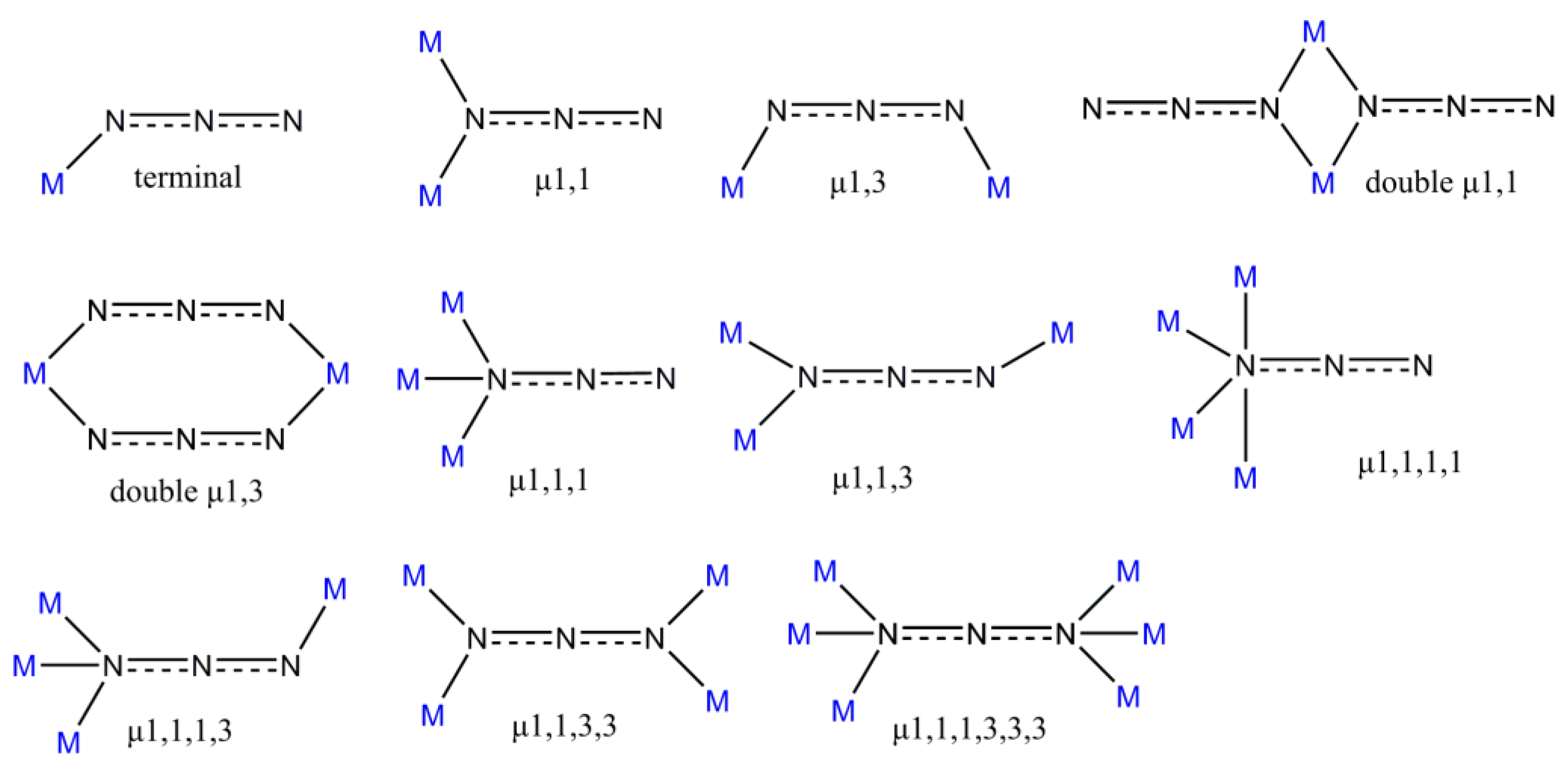

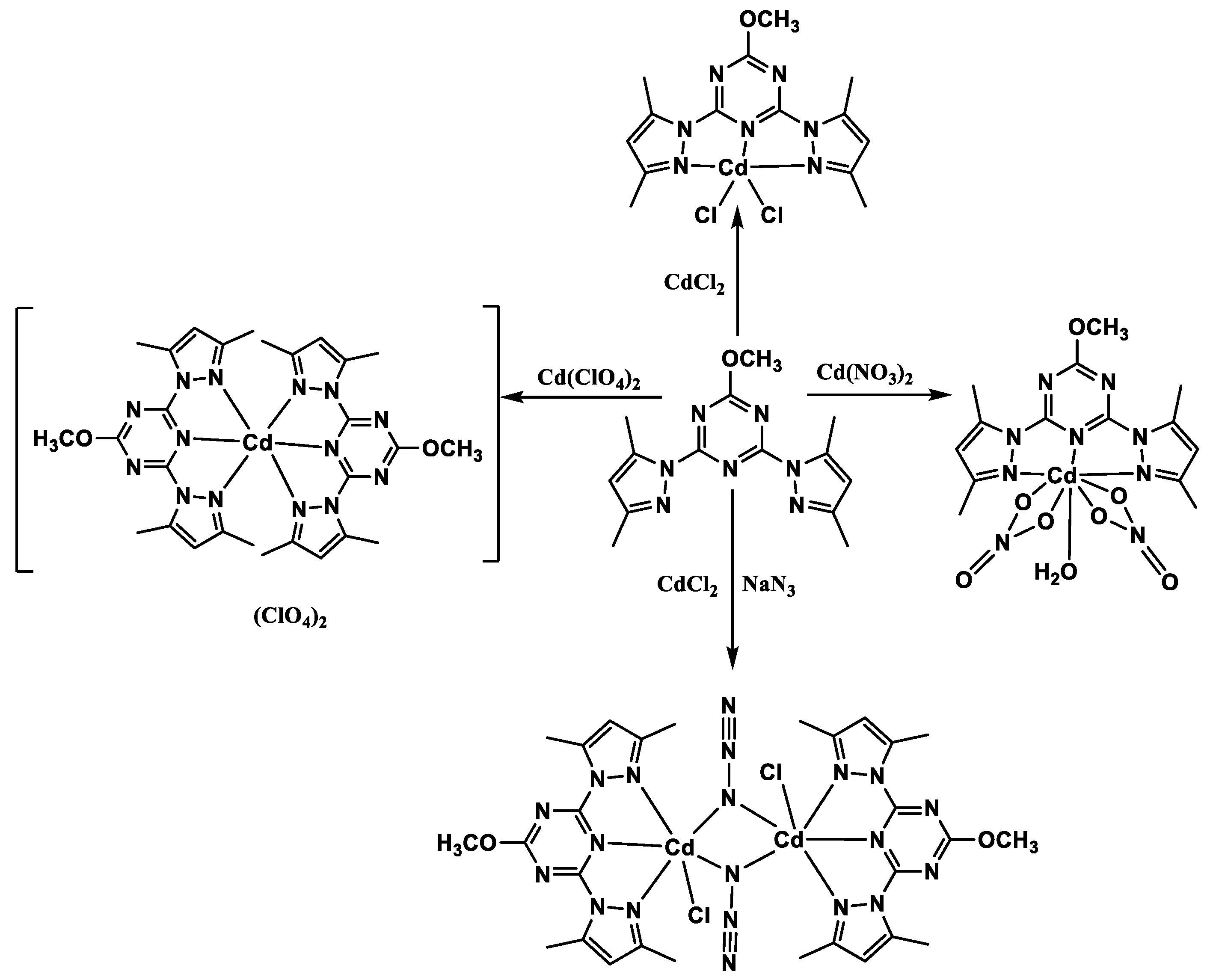
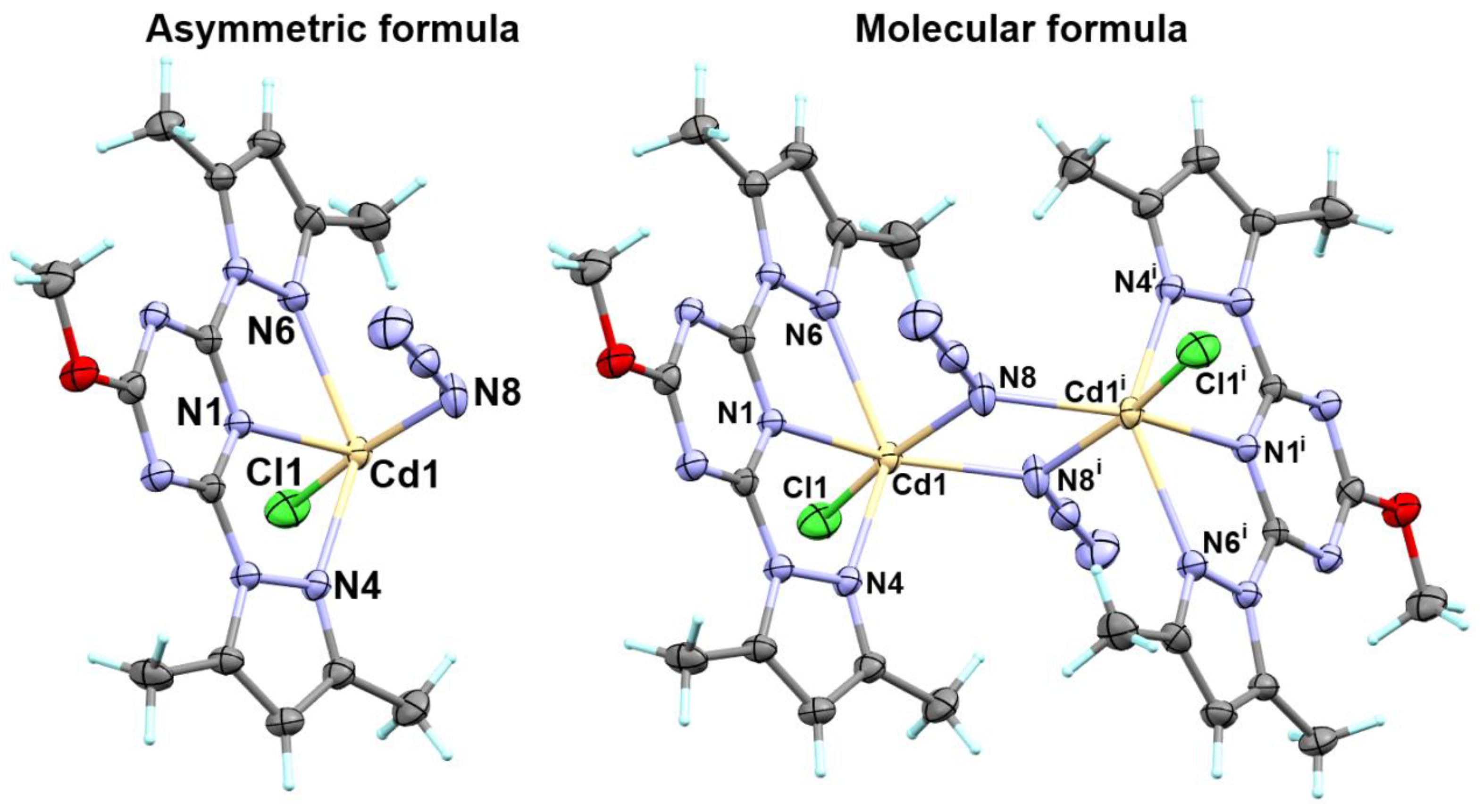
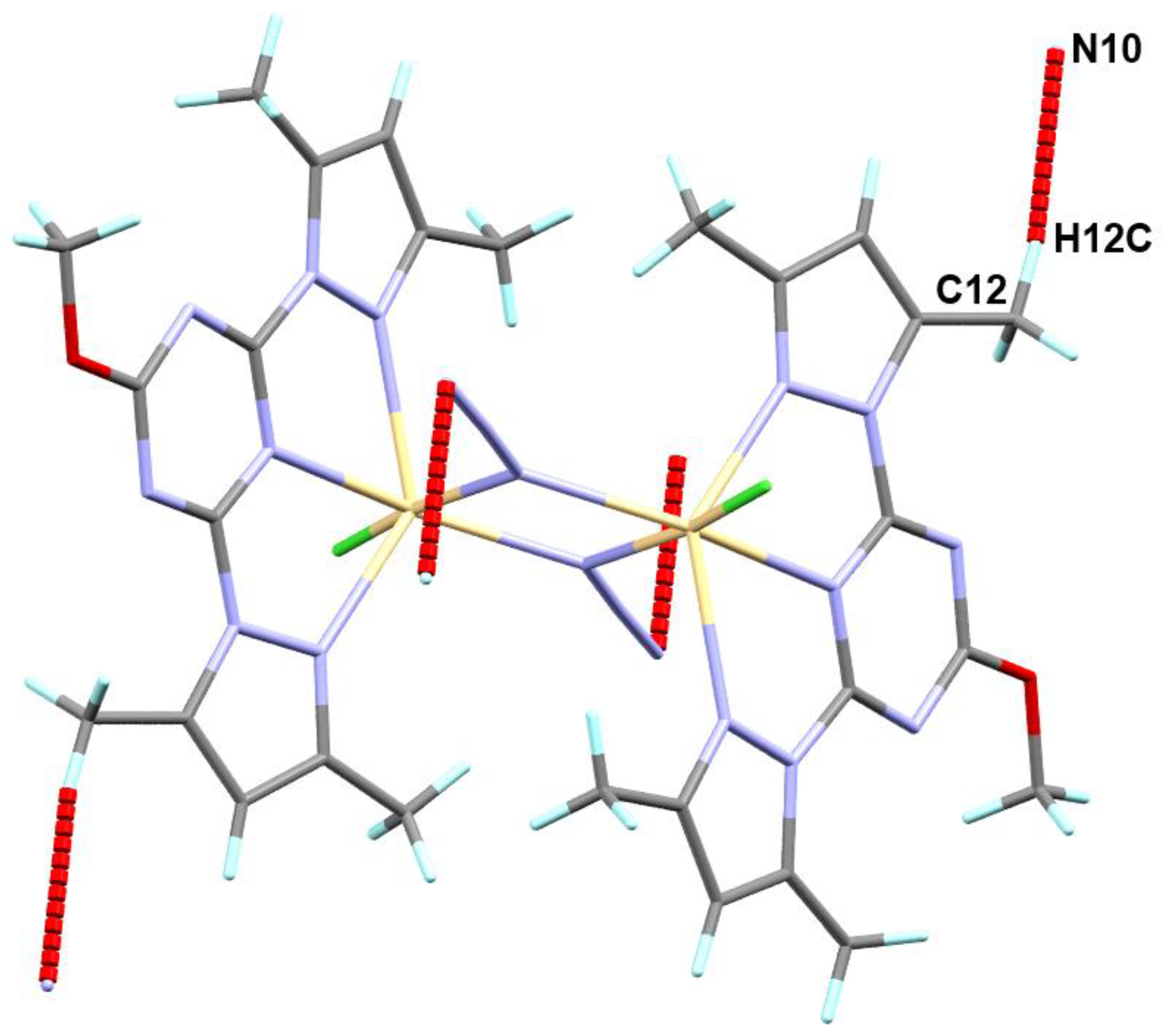

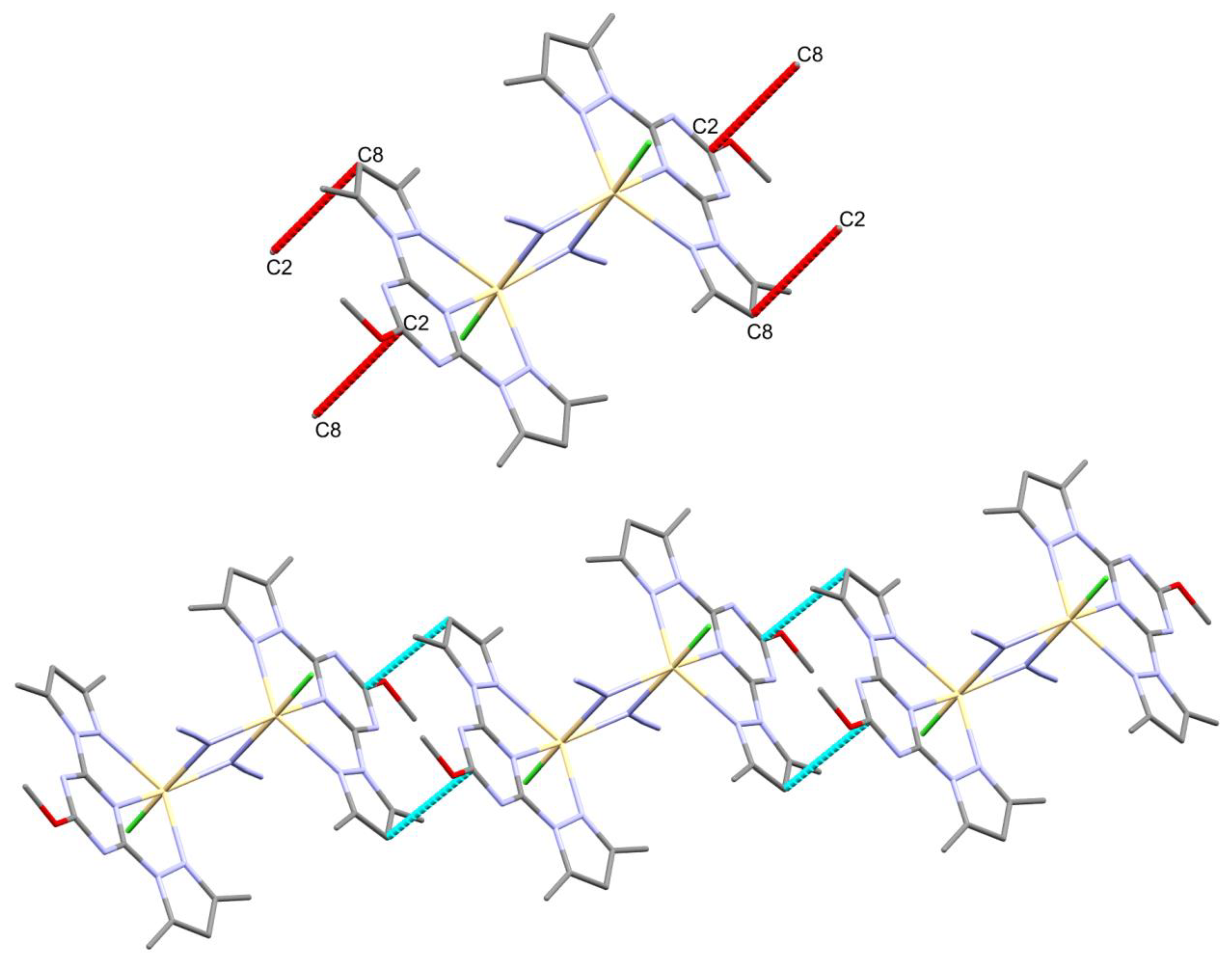

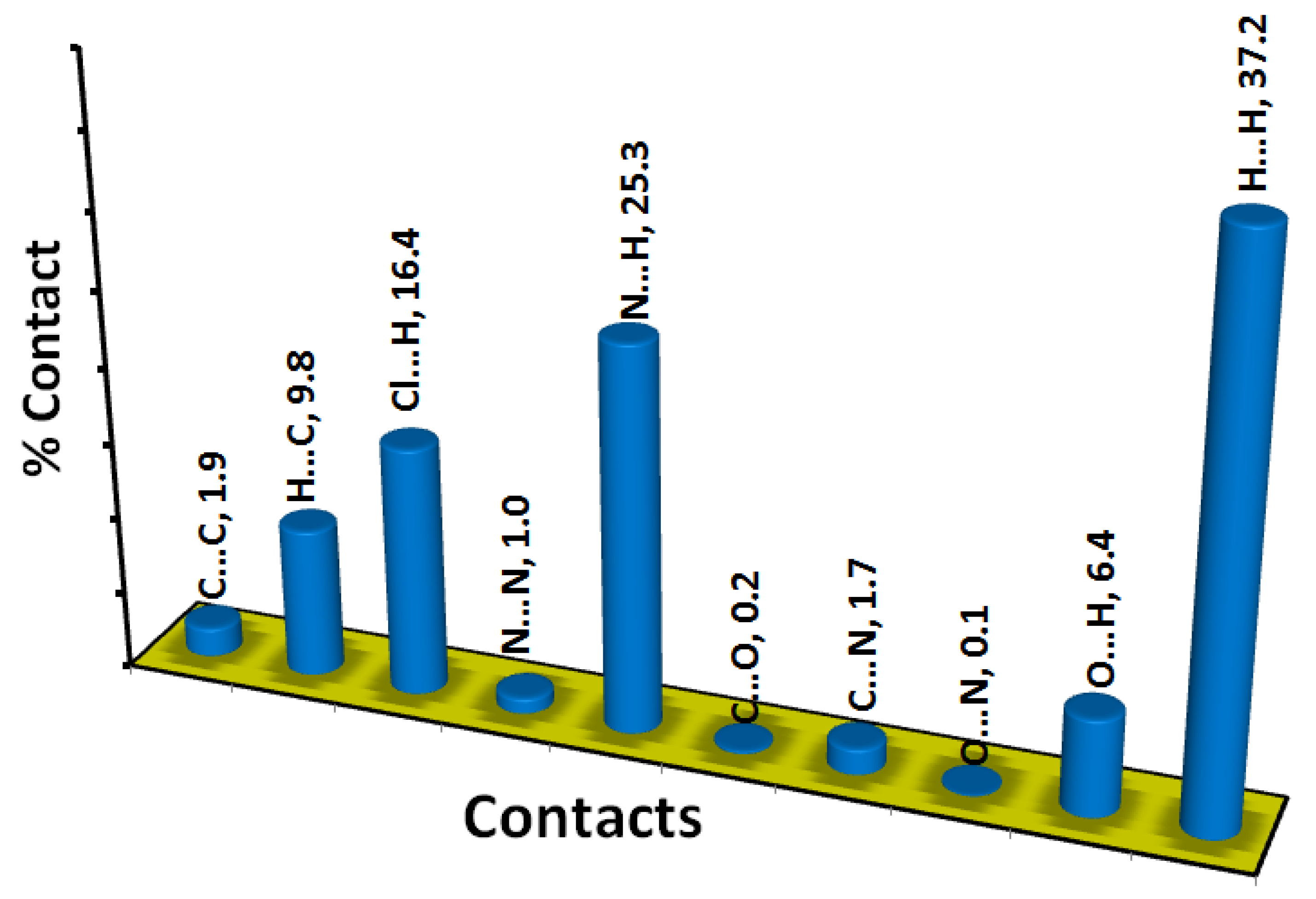
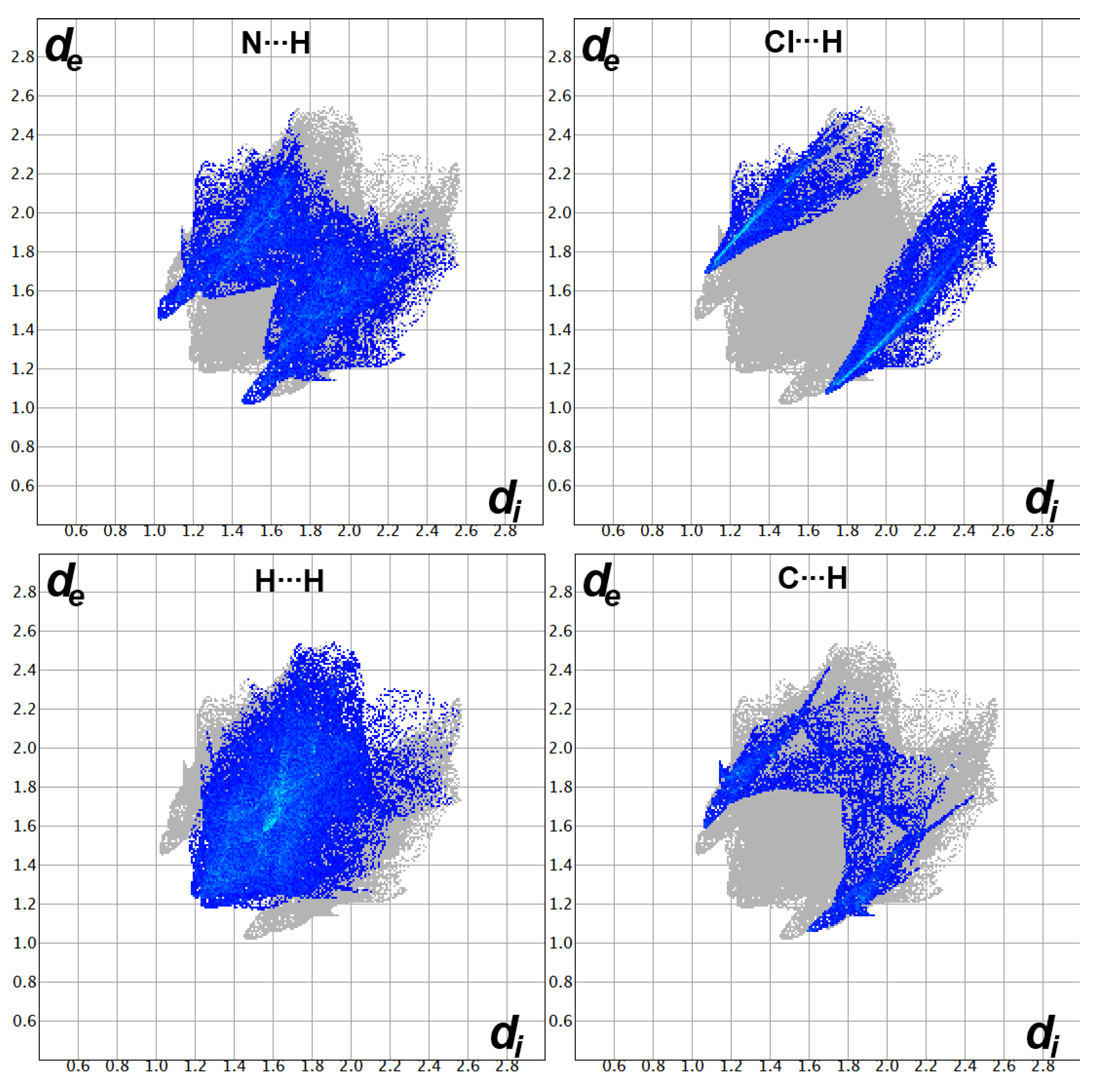

| CCDC | 2212588 | |
| Formula | C28H34Cd2Cl2N20O2 | |
| F.Wt | 978.45 g/mol | |
| T | 293(2) K | |
| Λ | 0.71073 Å | |
| Crystal system | Triclinic | |
| Space group | P-1 | |
| Unit cell dimensions | a = 9.323(4) Å | α = 112.637(10)° |
| b = 10.936(5) Å | β = 104.547(11)° | |
| c = 11.312(6) Å | γ = 105.133(10)° | |
| V | 944.1(8) Å3 | |
| Z | 1 | |
| D(calc.) | 1.721 g/cm3 | |
| Absorption coefficient | 1.326 mm−1 | |
| F(000) | 488 | |
| θ-range | 2.20 to 30.57° | |
| Index ranges | −13 ≤ h ≤ 13, −15 ≤ k ≤ 15, −16 ≤ l ≤ 16 | |
| Reflections collected | 40,395 | |
| Independent reflections | 5760 [R(int) = 0.0345] | |
| Completeness to θ = 25.35° | 99.10% | |
| Refinement method | Full-matrix least-squares on F2 | |
| Data/restraints/parameters | 5760/0/249 | |
| Goodness-of-fit on F2 | 1.175 | |
| Final R indices [I > 2sigma(I)] | R1 = 0.0321, wR2 = 0.0685 | |
| R indices (all data) | R1 = 0.0405, wR2 = 0.0752 | |
| Largest diff. peak and hole | 1.169 and −0.911 | |
| Bond | Distance | Bond | Distance |
| Cd1-N8 | 2.317(2) | Cd1-N8i | 2.416(3) |
| Cd1-N4 | 2.408(2) | Cd1-N6 | 2.452(2) |
| Cd1-N1 | 2.412(2) | Cd1-Cl1 | 2.4704(13) |
| Bonds | Angle | Bonds | Angle |
| N8-Cd1-N4i | 109.04(9) | N1-Cd1-N6 | 64.57(7) |
| N8-Cd1-N1i | 154.37(8) | N8-Cd1-N6 | 84.57(9) |
| N4-Cd1-N1 | 65.67(7) | N8i -Cd1-Cl1 | 95.60(8) |
| N8-Cd1-N8i | 73.38(11) | N4-Cd1-Cl1 | 95.93(6) |
| N4-Cd1-N8 | 90.66(9) | N1-Cd1-Cl1 | 109.74(5) |
| N1-Cd1-N8 | 81.49(8) | N8-Cd1-Cl1 | 168.57(6) |
| N8i -Cd1-N6 | 116.73(9) | N6-Cd1-Cl1 | 98.14(6) |
| N4-Cd1-N6 | 130.17(7) |
| Contact | Distance |
|---|---|
| Cl1…H14A | 2.769 |
| N9…H12C | 2.604 |
| N10…H12C | 2.487 |
| C5…H11B | 2.656 |
| H13A…H13C | 2.515 |
| C2…C8 | 3.462 |
| Atoms | BD | ρ | G(r) a | V(r) b | H(r) | ∇2ρ | |V(r)|/G(r) |
|---|---|---|---|---|---|---|---|
| Cd1-N8 | 2.317 | 0.0534 | 0.0700 | −0.0763 | −0.0063 | 0.2550 | 1.090 |
| Cd1-N1 | 2.412 | 0.0369 | 0.0579 | −0.0584 | −0.0005 | 0.2300 | 1.009 |
| Cd1-N4 | 2.408 | 0.0382 | 0.0579 | −0.0594 | −0.0015 | 0.2250 | 1.026 |
| Cd1-N6 | 2.452 | 0.0335 | 0.0505 | −0.0507 | −0.0002 | 0.2010 | 1.004 |
| Cd1-N8i | 2.416 | 0.0383 | 0.0567 | −0.0587 | −0.0020 | 0.2190 | 1.035 |
| Cd1-Cl1 | 2.470 | 0.0479 | 0.0707 | −0.0773 | −0.0066 | 0.2570 | 1.093 |
Publisher’s Note: MDPI stays neutral with regard to jurisdictional claims in published maps and institutional affiliations. |
© 2022 by the authors. Licensee MDPI, Basel, Switzerland. This article is an open access article distributed under the terms and conditions of the Creative Commons Attribution (CC BY) license (https://creativecommons.org/licenses/by/4.0/).
Share and Cite
Dahlous, K.A.; Soliman, S.M.; El-Faham, A.; Massoud, R.A. Synthesis, Molecular and Supramolecular Structures of Symmetric Dinuclear Cd(II) Azido Complex with bis-Pyrazolyl s-Triazine Pincer Ligand. Symmetry 2022, 14, 2409. https://doi.org/10.3390/sym14112409
Dahlous KA, Soliman SM, El-Faham A, Massoud RA. Synthesis, Molecular and Supramolecular Structures of Symmetric Dinuclear Cd(II) Azido Complex with bis-Pyrazolyl s-Triazine Pincer Ligand. Symmetry. 2022; 14(11):2409. https://doi.org/10.3390/sym14112409
Chicago/Turabian StyleDahlous, Kholood A., Saied M. Soliman, Ayman El-Faham, and Raghdaa A. Massoud. 2022. "Synthesis, Molecular and Supramolecular Structures of Symmetric Dinuclear Cd(II) Azido Complex with bis-Pyrazolyl s-Triazine Pincer Ligand" Symmetry 14, no. 11: 2409. https://doi.org/10.3390/sym14112409






